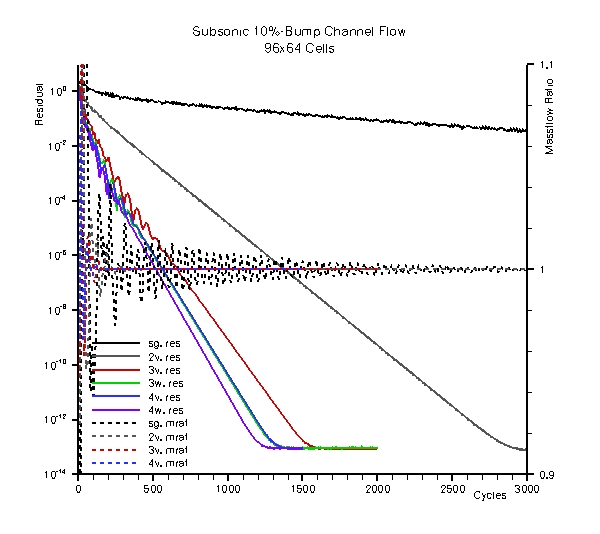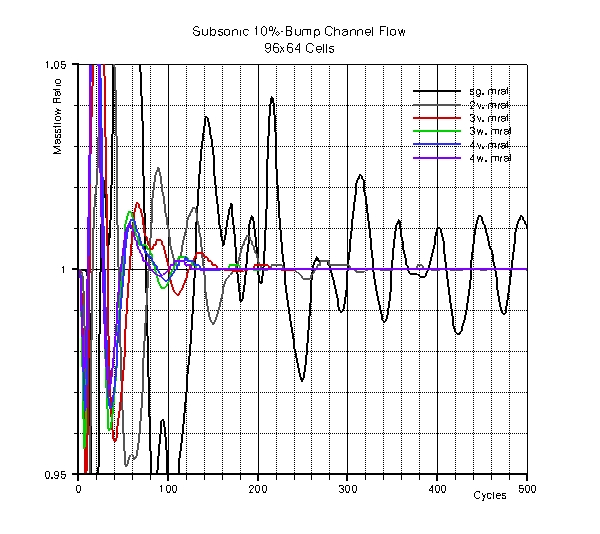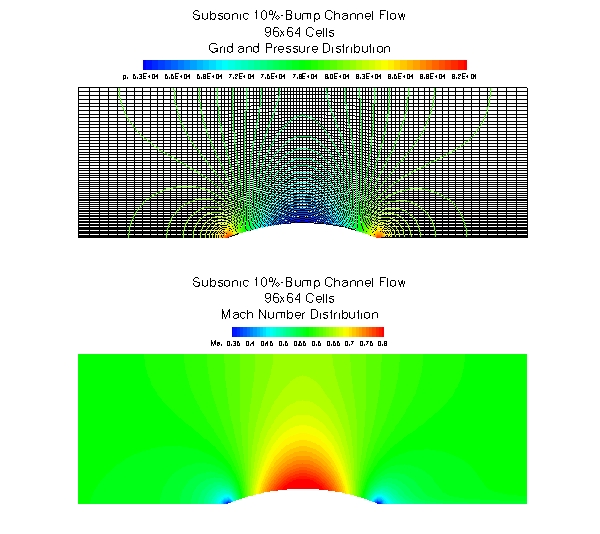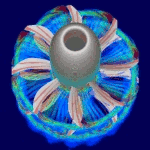 |
|
 |
Presented here is an example of a complete solution of a subsonic internal channel flow over a 10% bump.
This test case, a commonly used reference case, is run in 2DE by specifying an inflow total pressure of 1e5 N/m^2,
an inflow total Temperature of 300K, an outflow static pressure of 8e4 N/m^2 and a pressure ratio across the channel of 1.
Using a single block, structured euler grid of 96x32 cells this case serves to demonstrate the convergence improvements to be
achieved with the use of multigrid. Initially a single grid run is performed, which exhibits an extremely slow rate of convergence.
This problem is solved though the use of multigrid, as the results for a run using various 2-, 3- and 4-grid cycles demonstrate.
For all three computations the solver run is done using local time-stepping, a CFL number of 7.5, implicit residual smoothing with variable
coefficients scaled with an epsilon of 0.8, and 2nd and 4th order artificial viscosity terms scaled with factors of 0.5 and 1/64 respectively. For the multigird cases
the coarse grid corrections are smoothed using a constant coefficient of 0.01 on all grid levels.
|

Comparative plot of the density residuals and the mass flow ratio across the channel for the various solver runs.
The single-grid computations show a very poor rate of convergence in terms of the density residual and still
exhibits fluctuations in the mass flow ratio after 3000 cycles. A significant improvement can already be achieved
by using a 2v-multigrid cycle, which leads to a bottoming out of the density residual after 3000 cycles.
Using a 3v-multigrid cycle results in a fully converged solution after 1600 cycles, while machine accuracy is
achieved after 1400 cycles for both a 3w- and a 4v-cycle. For the 4w-cycle a fully converged solution can be
reached after 1300 cycles, which is the lowest number of iterations of all of the multigrid cycles tested.
|

The benefit of running this case with multigrid also becomes evident when looking at the evolution of the
mass flow-ratio across the channel during the first 500 cycles of the various computations. The single grid run
shows strong oscillations which can be damped out much earlier using multigrid acceleration. Much like the
situation for the overall rate of convergence described above, using more grid levels as well as using a w-
instead of a v-cycle tends to speed up the damping out of oscillations in the mass flow-ratio, with the 4w-multigrid
cycle leading to a constant value after only about 150 cycles.
|

The 2D-contour plot of the mach number distribution shows completely subsonic flow through the channel, with only a slight acceleration
on the top of the bump. The top image shows iso-lines of pressure superimposed on the grid of the finest level
used in this study.
|
|
Case
|
Cycles (to 1e-13)
|
Mass flow [kg/s]
|
Mass flow Ratio
|
Runtime [s]
|
Ave. Time per Cycle [s]
|
Time to Convergence [s]
|
SG |
3000 (-) |
190.8 |
1 |
449 |
0.149667 |
- |
2V |
3000 (2896) |
190.9 |
1 |
630 |
0.21 |
608.16 |
3V |
2000 (1578) |
190.9 |
1 |
461 |
0.2305 |
363.729 |
3W |
2000 (1362) |
190.9 |
1 |
566 |
0.283 |
385.446 |
4V |
1500 (1352) |
190.9 |
1 |
346 |
0.230667 |
311.861784 |
4W |
1500 (1253) |
190.9 |
1 |
364 |
0.242667 |
304.061751 |
This table lists details pertaining to the convergence and run times for the various cases. The value in
parentheses in the cycle column is the iteration at which the density residual drops below a value of 1e-13
for the first time. This convergence criteria is somewhat arbitrary but does allow for a fairly accurate
comparison of the time-to-convergence as the final density residual fluctuates around a value of 9e-14 for
all cases. For all cases the physically relevant properties mass flow and mass flow ratio have reached identical
values at convergence. Of interest is the time to convergence, which is a product of the average runtime per
cycle and the iteration number at which the density residual reaches 1e-13. It shows - with one notable exception -
that the improved convergence rate of w-cycles over v-cycles and of increasing the number of multigrid levels
also translates to an overall increase in efficiency, i.e. runtime to convergence. However the 4w-cycle does
seem to be close to the optimum in terms of efficiency, as the improvement over the 4v-cycle is relatively small.
The notable exception mentioned is the 3w-cycle, which is slightly more expensive than the 3v-cycle in terms
of compute time. A possible explanation for this is that here three rather expensive Runge-Kutta cycles on the
2nd finest grid level need to be performed per cycle, while only two are required for the 3v-cycle. The extra
RK-cycle on the 3rd finest grid level for the 4w-cycle versus the 4v-cycle on the other hand seems to be less
costly and more effective in improving convergence, making the time to convergence for the 4w-cycle the quickest
of the cases tested here.
|
|
|
 |


